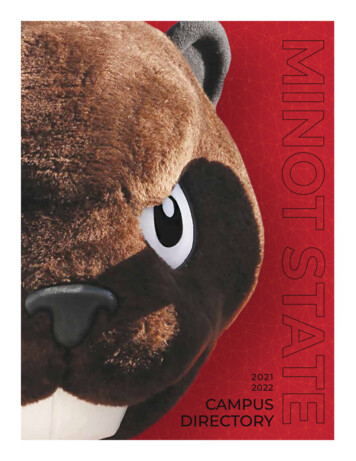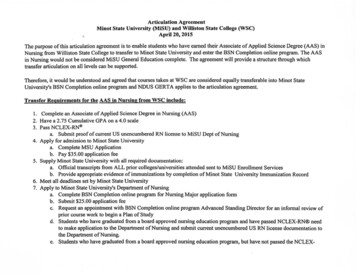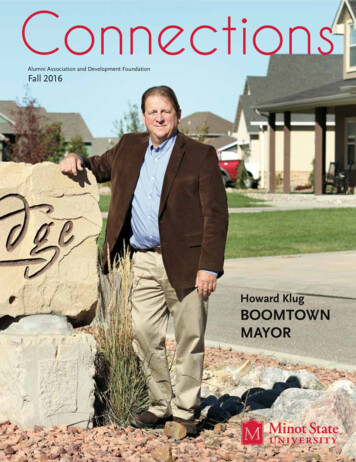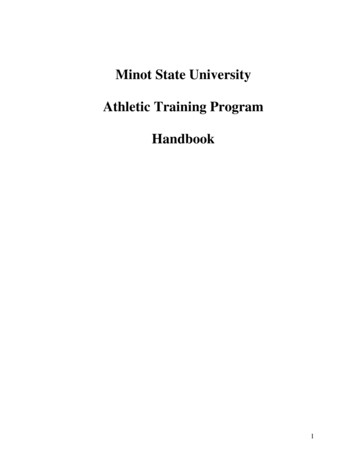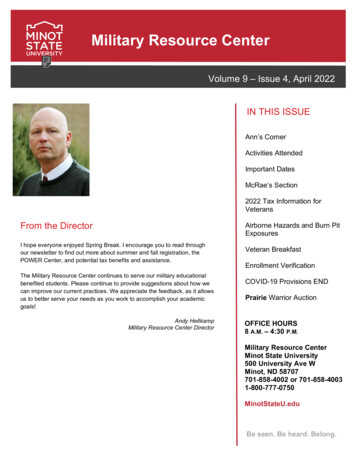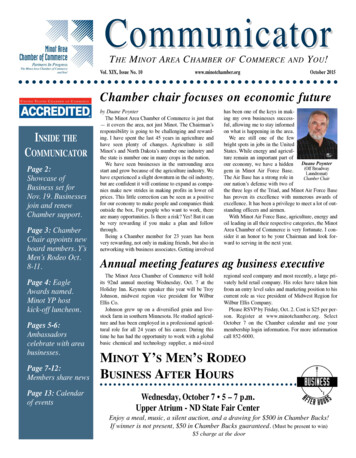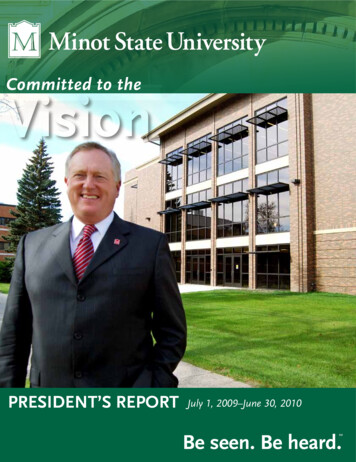
Transcription
Committed to theVisionPresident’s ReportJuly 1, 2009–June 30, 2010
VisionCore values are deeply imbedded in the minds of the people who serve and sustain the institution and arereadily recognized and appreciated by those served by the institution. Planning for the future depends on theaffirmation of Minot State University’s core values and core purpose. Minot State University is built upon acommitment to students, learning, service, and cooperation, and upon a respect for people and place.Core ValuesMSU cares deeply about its students, their learning, and their growth. The university is proud of its valuesand long-term commitment to:nTeaching and learning with excellence, integrity, and engagementnServing students and others respectfully and responsiblynFollowing high ethical and moral principlesnSupporting the values of community and place, where all community members are valued and respectedfor their work, contributions, and freedom of expression.Core PurposeMinot State University helps people appreciate life and learning and contribute meaningfullyto the lives of others.
ACampus landmark undergoes a renovationpagerefurbished Swain Hall reopened this fall to servestudents of the 21st century.The former athletic facility is the new home of the Department of Teacher Education and Human Performance.The first floor houses labs for physiology and athletic training.The spacious facilities boast cutting-edge equipment for use byhuman performance majors.“That’s the best athletic training facility for 500 to 600 milesin any direction,” said Neil Nordquist, dean of the College ofEducation and Health Sciences.The second floor features a replica of a high school gymnasium that will be used as a pedagogy lab. The same level featuresmethods classrooms where education majors will work withpreschool and elementary students.The floor also houses the Center for the Applied Studyof Cognition and Learning Sciences (CASCLS, pronounced“Castles”). CASCLS couples brain research with practicalclassroom applications.4Newly renovated Swain HallMSU’s reading clinic is also located on the second level.University students teach elementary students to read, especiallyones who are struggling. The clinic features high-tech camerasand sound equipment.“We can record our students working with children who havelearning disabilities,” Nordquist said.‘ The spacious facilities boast cuttingedge equipment that’s the bestathletic training facility for 500 to600 miles in any direction.’— Neil NordquistDean of the College of Educationand Health Sciences
The third floor includes new classrooms and laboratories.Currently, the Division of Science is using the space.Administrators believe the new building will be a magnet forstudents and faculty alike. Jaimie McMullen, a leading authorityon pedagogy in physical education, is a case in point. She arrivedat MSU this fall from Arizona State University.“One of the big reasons she came here was the building,”Nordquist said.The building’s south end features conference rooms andlounge areas with bright lighting, comfortable furniture andsweeping views of the campus.The remodeling effort cost 12.6 million and was supplemented by federal stimulus funds, funding from the state ofNorth Dakota and Minot State University.Three general contractors worked on the project’s threephases. They included Environmental Plant Services of St. Paul,Minn., Mackley Construction of Minot and Mattson Construction of Minot.Swain Hall will eventually connect to a projected Health andWellness Center via a skywalk over 11th Avenue.Swain Hall is named for Carl Swain, the university’s fourthpresident (1938 to 1954). The building was dedicated in hishonor in 1952.Swain Hall served as home for the physical education department and field house for indoor sports for three decades. Whenthe Dome became the primary athletics facility in the 1980s, thefacility served mainly as a practice facility. It also housed coaches’offices, football locker rooms and a fitness center.page5captionSecond floor commons areaClassroomPedagogy Lab for physical education
researchDigging into the past to understand our placepage6The first summer of digging into the past of the FirstLutheran Church Cemetery in Minot is now in the books, withthree more summers to go. The historical-archeological project isthe brainchild of Mark Timbrook, technology support specialist in MSU’s Office of Instructional Technology, adjunct facultymember and author. And while he is often too humble to admitit, Timbrook is truly dedicated to understanding the history ofthe cemetery and involving students and others in his passion forhistory and research.The cemetery is located just to the east of the Student Centerand Administration Building, right next to North Broadway.It was first platted in 1892. Timbrook’s research project istied directly to a new class at Minot State University —Special Topics in History: Historical Archeology, GraveyardPreservation.Among other objectives, the unique course is designed to mapthe cemetery grounds, document its history and grave markers,uncover submerged markers, locate unmarked graves, clean gravemarkers, research individuals interred, develop an interactivewebsite of the compiled information, work closely with FirstLutheran on a preservation plan and develop signage to add tothe cemetery’s sense of place within the community.No easy task.But one that Timbrook is doing with help from other faculty,including Joseph Jastrzembski, history, and Margaret Sherve,English, as well as interested students.captioncaptionMisty Neumiller and Jacob Jenkins, both of Minot, participated in the cemetery preservation course this past summer andpresented their findings to both First Lutheran Church and acampus audience during a Northwest Art Center Lecture.
The project is designed to run through 2013 with a newquadrant of the cemetery to be explored each summer.Following their cemetery preservation project in June,Sherve, Timbrook and four MSU students spent two weeks inJuly working with Michael Fosha, chief archaeologist for theSouth Dakota Archaeology Research Center, excavating historicFort James, near Mitchell, S. D. The fort was constructed in1865, a consequence of the Great Sioux War.Students successfully identified the fort’s south, east and westwalls, as well as the walls of the enlisted men’s barracks, wareroom and quartermaster’s area. They excavated a large numberof cut nails, glass from various types of bottles and containers, window glass, tin fragments, bone fragments from regionalfauna discarded during the occupation, seeds, timbers from thefort’s flooring, pottery shreds and charred wood from the fort’sdestruction in 1868.Minot State students were the first to unearth the treasuresof Fort James. Students will return to the site in 2011.Undergraduate on the HillThis event helps members of Congress to better understandthe importance of undergraduate research by talking directlywith the students whom the federally funded programs impact.Young’s research focuses on the rapid synthesis of piperonylformamide. Specifically, Young developed a new method ofsynthesis of an important natural product that could be used forthe preparation of safe natural pain-killers and other medicines.Young completed his work in the lab of Mikhail Bobylev,associate professor of chemistry.Undergraduate research grantrenewedMore than 3 million in biomedical research grant moneywill allow Minot State to continue providing science researchopportunities for undergraduates. Five Minot State Universityfaculty members will split the university’s portion of the NorthDakota IDEA Network of Biomedical Research Excellence grant.“What this gives students and faculty at Minot State is thesupport needed for salaries and projects that allow one-on-oneresearch with undergraduates,” said Chris Beachy, principalinvestigator at Minot State University and professor of biology.“What we’re all focusing on is the role cadmium, a heavy metal,plays in North Dakota’s environment and human health.Cadmium can have many adverse environmental effects, including causing several types of cancer.”The INBRE grant will also make it possible for students togive presentations at national meetings and allow for collaborations with tribal colleges.U.S. Senator Ken Conrad, Zane Young, Mikhail BobylevFor the second year in a row an undergraduate student fromMinot State was chosen to present at a prestigious nationalconference. Zane Young, of Minot, was selected by the Councilon Undergraduate Research for a presentation at the 2010 Posters on the Hill in Washington, D.C. During the event about 60undergraduate students from the entire nation presented theirresearch to the members of the United States Congress on CapitolHill. The students and their faculty advisors spent the entireday in the US Capitol, first meeting with their state Representatives and Senators, and then presenting their research during theposter session.captionpage7
academicsHelping all students succeedpage8New admission standards, along with recent support programsdesigned for freshman students, will give more students at MinotState University a chance to reach their educational goals.“Minot State University is empowered with the mission, firstand foremost, of being dedicated to the success of all students,”said David Fuller, president of Minot State University. “As auniversity, we need to better assist these students in the difficulttransition from high school courses to life as a student of highereducation.”The previous standard of admitting any student who had atleast an ACT score of 17 has been changed to allow for morestudents to succeed. Most students will now need to attain atleast an 18 on the ACT along with the appropriate high schoolgrade point average. To receive the needed support to help themsucceed, admitted students with ACT scores between 18 and 21will receive special guidance as to courses and total enrollments,based on their specific academic needs and preparation. Studentswill receive personalized guidance and support for their potentialacademic success and persistence. Students with a 22 ACT orhigher and those who earned a 3.25 GPA or higher will beadmitted to MSU without any provisions.The new standards nd18-19/860-930andPassport Program (see below)H.S. GPA Range3.25 Any2.5 - 3.2493.0 - 3.249Students are encouraged to apply even if their test score orGPA does not fall within the standards of the admission chart.The new admission standards will not impact students who aretransferring to Minot State University.The Passport Program, a unique collaboration betweenMinot State and Dakota College at Bottineau, ensures thosestudents who want a four-year degree from MSU but do notyet have the test or grade point necessary can still receive theappropriate courses and educational opportunities. With thePassport Program, a student will take 24 credits of classes fromboth DCB and MSU on the Minot State University campus.In their second year, they can transition seamlessly into MinotState as a full-time student.
‘ Minot State University is empowered with the mission, first and foremost,of being dedicated to the success of all students.’— DR. DAVID FULLERPresident“Our new admission standards are about much more thansimply raising some of the standards for admitting new students;it’s about providing the right opportunities for students in northwest North Dakota and throughout the region to succeed,” saidKevin Harmon, dean of admissions.CETL focused on freshmenstudentsThe Center for Engaged Teaching andLearning launched in September of 2009after the university received Title III fundsfrom the U.S. Department of Education.CETL provides a number of programsto foster student success. These programsinclude first-year experience courses,engaged teaching support as well ascampus and community engagementopportunities for students.The first-year experience is a hallmarkchange geared toward helping studentstransition from high school to MinotState University. Incoming freshmen aredivided into small groups (15-20 students) based on majors and interests andwill register for the same three courseswithin their first semester. These coursesare centered on a theme or idea. Theclasses will fulfill general education requirements and give thenew students a core group of similar students with whom tostudy and rely on. Each set of first-year experience courses are ledby a trio of faculty members and CETL staff.CETL is also collaborating with the Student Success Center(formerly Office of Career Services) to provide more support forstudents, along with a refocused mission to include additionaladvising and tutoring services.Enrollment numbers increaseOfficial fall 2009 enrollment numbers at Minot StateUniversity showed a 6.3 percent increase compared to officialnumbers from 2008. The number reported to the North DakotaUniversity System was 3,649, an increase of 217 students. Thismarks the largest single-year increase since the fall of 2001.“We were very happy to be able to recruit quality studentsinterested in a Minot State degree from across Ward County,the region and the world,” said David Fuller, president of MinotState University.Fall 2009 enrollment showed a new six-year high amongNative American populations, at 147 students; a new 11-yearhigh in students from Canada, at 293; and a new all-time highfor enrollment in non-traditional learning, as more than 1,300students took at least one course online or through interactivevideo networking.The number of Minot State graduate students increased to304, and the number of students from Ward County increasedalmost 6 percent to 1,979.Minot State experienced growth in students from largercounties across the state as well as from counties in northwestern North Dakota. The counties of Bottineau, Burke, Cass,Grand Forks, McHenry, Mountrail, Pierce, Renville, Rolette andSheridan all saw more students interested in earning their degreesfrom MSU.Recruiting and marketing efforts also netted an increase instudents from states in the region, including Minnesota, SouthDakota and Wyoming. In addition, the number of students fromWashington, Florida and Texas increased as a result of strategicenrollment efforts.
serviceNational community serviceaward honors Minot Statepage10The 2009 President’s Higher Education Community ServiceHonor Roll includes Minot State University. This was the firstyear the school received this high recognition. MSU was theonly college or university in North Dakota to earn this awardin 2009.Being on the Community Service Honor Roll is the highestfederal recognition an institution of higher education can receivefor its commitment to volunteerism, service learning and civicengagement.“We’re more than pleased to receive this presidential honorfrom the Corporation for National and Community Service,”said David Fuller, president of Minot State University. “Whilewe’ve felt for some time that we were reaching out to the community in many special ways, being on this honor roll validatesthose achievements and gives us incentive to continue to connectwith groups in need as well as to assist in solving society-basedconcerns and issues.”Some examples of Minot State volunteer, service-learning orcivic-engagement projects that MSU is proud of include:The Adult Health Maintenance Clinic, a hands-on, servicelearning experience for students to assist senior citizens at HenryTowers with vital health concerns.Freezin’ for a Reason, an activity in which the MSU StudentSocial Work Organization promoted awareness and raised donations to assist the homeless in the region.Champions of Character/Dream Catchers Day, an opportunity for youth with disabilities to participate in a baseball game,with MSU student-athletes as teammates.Minot State was chosen for the honor roll based on a series ofselection factors, including the scope and innovation of serviceprojects, percentage of student participation in service activities,incentives for service and the extent to which the school offersacademic service-learning courses.MSU helps Haitian earthquakevictims in many waysOn Feb. 8, Ernst Pjining, Faculty Senate president, and MattSchaefer, Staff Senate president, presented Allan McGeough,director of the Mid- Dakota Chapter of the Red Cross, withmore than 3,600 in donations. The donations are from MinotState University students, faculty, staff and alumni in support ofthe relief and recovery effort. A 7.0 magnitude earthquake hitthe island country of Haiti in mid-January, affecting more thanthree million people, killing more than 200,000 and injuring anestimated 300,000 people.Along with a campuswide appeal to donate, the MinotState University Bookstore and Chartwells Dining Services alsoworked with the Red Cross. Individuals purchased AmericanRed Cross squares for 1 each in the bookstore or any Chartwells location. The squares with donors’ names were displayedon campus. The Red Cross received the proceeds.
athleticsMoving forward toward Division IIMinot State University made significant strides toward becoming an NCAA Division II school during 2009-10.The university overcame the first hurdle in July when it was granted Candidacy Year Two status by the NCAA. The move from YearOne to Year Two is a key step in the three-year process.The school made several strides in the area of compliance — hiring Melanie DeBoer-Brunsdon, assistant athletic directorcompliance; producing a detailed budget; constructing a compliance handbook and a student-athlete handbook; meeting with officialsat Minnesota State-Moorhead, an NCAA Division II school; and attending the NCAA national convention.The progress was noted by the Northern Sun Intercollegiate Conference, which visited to Minot State in October. Conferenceofficials met with MSU administrators, academic representatives, athletic staff, coaches, boosters and community members in consideration of Minot State’s application for admittance into the conference.Minot State will learn its fate after NSIC officials meet in January 2011. MSU is working toward Candidacy Year Three in July 2011.Banner year sees four teams compete in nationalspage11Minot State University had four teams qualify for NAIAnational tournaments during the 2009-10 school year.The football program led the way by winning nine games andqualifying for the NAIA National Football Championship Series.During the season, MSU defeated NCAA Division IIConcordia-St. Paul 24-21 at home, ran off six straight conference wins and defeated Jamestown College in the inauguralDacotah Bank DAC Bowl in the FargoDome.The Beavers fell to No. 1-ranked University of Sioux Falls(S.D.) in their first national playoff appearance since 2002. MSUfinished the season ranked No. 11 in the NAIA coaches’ poll.Next, it was the women’s turn to shine. In fact, MSU hadthree women’s teams qualify for nationals.The MSU women’s basketball team tied a school record forwins with 21. It made its sixth NAIA national tournamentappearance with an at-large bid. MSU has qualified for nationalsin four of the past seven seasons.The Beavers entered the national tournament as a No. 5 seedin their bracket and faced Grand View (Iowa). The teams battledin an evenly matched game, but Grand View pulled away andwon 63-53.The final two teams to make national tournament appearances did it for the first time in their histories.The softball program defeated Dickinson State at the DakotaAthletic Conference tournament to earn a bid to the NAIASoftball National Tournament in Decatur, Ala. During theseason, MSU had a record 17-game winning streak.The Beavers made the most of their first appearance, going2-1 in pool play and tying for first. MSU lost the tiebreaker toeventual national runner-up Oklahoma City.The final team to earn a national tournament berth was thewomen’s golf program. Four seasons ago, MSU fielded just twovarsity players. In the fall of 2009, the Beavers won their firsttournament. Just a few months later, MSU had its first-everDAC title and a trip to the NAIA Women’s Golf Tournamentin Rapid City, S.D.MSU finished 23rd in the event. First-year player Kara Dietzhad the Beavers’ low score of 345.Nine individuals from Minot State’s track and field and crosscountry teams also gained national tournament berths.In cross country, sophomore Brandon Velasquez and firstyear runner Breyette Schall qualified for the national meet inNovember.Indoor track and field qualified seven athletes in 12 events fornationals. Junior Zach Ryan finished second in the high jump,while Khaldon Evans finished fifth in the 400-meter. Both werenamed All-American for the 2010 Indoor season.Eight runners qualified in the outdoor season, with AbbeyAide the highest-placing Beaver competitor. Aide cleared 11-9in the pole vault for eighth place.
facilitiesMinot State unveils unique monument signcaptionMSU has put out a new welcome mat at the corner ofBroadway and University Avenue.The school erected a monument sign to trumpet its presencein the Minot community.Walter Piehl, an MSU art professor, designedthe sign and assisted landscape architects and contractors in its implementation.“You can’t just turn over drawings; you have tobe on site,” said Piehl, a nationally acclaimed artist.The sign features profiles of MSU buildings,school colors and natural landforms from theregion. Large boulders, called glacial erratics,dominate the design. Ornamental grasses, wildflowers and native shrubs complete the four-seasonlandscape.Piehl visited several gravel pits to select just theright boulders, which were later donated to theschool by Gravel Products of Minot.“I have a lot of experience in moving rocks,” theMarion native said. “In my youth, I did spend a lotof time picking rock out in the field.”Mattson Construction built the monumentsign, and Quality Landscaping did the landscaping.Both are Minot firms. Partial funding for the project came fromthe MSU Board of Regents.The original Broadway sign, donated by the class of 1966,was relocated to the MSU Amphitheater. University officialsplan to add an electronic information sign at the corner ofBroadway and 11th Avenue.
Herb Parker Stadium gets a makeoverHerb Parker Stadium has a dynamic new look this fall.The 45-year-old facility now features an expanded surface,state-of-the-art artificial turf, improved drainage and new lighting.Kraus-Anderson Construction of Circle Pines, Minn.,managed the five-month renovation project.Workers first removed the running track to make room fora soccer field. MSU fielded a women’s soccer team for the firsttime this fall.Technicians then replaced the natural grass with FieldTurf.The artificial surface is composed of polyethylene fibers in apolypropylene backing. The fibers resemble blades of grass.The infill is composed of a bottom layer of sand, a middle layerof sand and rubber, and a top layer of rubber. The materials arepermeable and allow water to drain through the backing.The artificial surface offers increased safety, improveddurability and low-cost maintenance when compared tonatural grass. Eleven NFL teams currently play on FieldTurf.“It’s the top artificial turf that’s made,” said Rick Hedberg,MSU athletic director. “The kids who have played on it reallylike it.”In the fall, the new field hosted six soccer and football gamesin eight days, demonstrating its indifference to the vagaries ofNorth Dakota weather.“The surface doesn’t change, whether it’s wet or dry,”Hedberg said. “”It’s got an unbelievable drainage system.Within 15 minutes, you won’t be able to tell it rained.”The new surface serves as a large drain field, with rainwaterdraining out the southwest corner into the city’s storm sewer.The new lighting system requires only four standards toilluminate the expanded field.Workers constructed a berm along the west and southwestends of the field. Combined with the soon-to-be-built Healthand Wellness Center west of the Dome, the landscaping willcreate a bowl-like effect.Hedberg believes the new field will be an important recruitingtool for Minot State coaches.“Once you see that field in person, you get that ‘wow’ factor.That’s big for kids,” he said.The athletic director also hopes the field will impress NorthernSun Intercollegiate Conference officials. MSU hopes to join theconference as it transitions from NAIA to NCAA Division IIstatus.“They’re going to be looking closely at our facilities acrosscampus,” Hedberg said.Renovation of the playing field is the first phase of the stadium upgrade. Phase II involves replacing stadium seating. PhaseIII will see suites added to the press box and the facility’s boxoffice, concessions stand and bathrooms brought under one roof.Both Phase II and Phase III will require funding and State Boardof Higher Education approval.Parker is a former coach, athletic director and administrator atthe university.page13
student lifeGreeks are Back!page14 And so is the Marching Band!26 years is a long time to wait in between performances. But that wasn’t about tostop a dedicated group at Minot State from reviving the MSU Marching Band. Andwhat a revival it was!2009 saw the return of the MSU Marching Band to the streets of Minot and thefield at Herb Parker Stadium.Joe Alme marched in the MSU marching band 40 years ago, now he teaches atthe university as an assistant professor. Alme led the charge to bring themarching band back.“We had a powerful marching bandat that time. And it was exciting andwe are trying to resurrect that feelingof enthusiasm and school spirit,” saidAlme.Reviving the marching band was alot of work. In the summer of 2009,Alme made phone calls to hundreds ofcollege students and incoming freshmen with band experience. Along withother dedicated professionals in theDivision of Music, Alme has managedto recruit about 60 musicians so far,enough to kick off the program and getthe proud spirit of marching at MSUback on track.With its third pledge class now inplace, the Mu Sigma Tau fraternity is thefirst Greek organization on campus sincethe late 80s. As a result of a Mu SigmaTau reunion at the 2009 MSU Homecoming, the MST Alumni Associationbegan the process of reactivating the oldorganization. Finding interested pledgeswasn’t difficult and by March 2010 theinitial group of seven, with Chase Lee aspresident, was off and running.“It’s truly a special feeling to be part ofthe return of Greek life to Minot State’scampus, especially as part of Mu SigmaTau. We’re honored to be carrying onsuch a rich tradition,” Lee said.The Mu Sigma Tau’s trace their rootsback to 1926, with their Greek lettersrepresenting the school’s name then —Minot State Teachers College.Along with the Mu Sigma Tau, otherfraternities and sororities are consideringa return to Minot State.
scholarshipsATHLETICAufforth/Marean/Coleman Athletic ScholarshipBeaver Booster Athletic Scholarship EndowmentBert Leidholt Scholarship EndowmentClyde A. “Stretch” Nelson Scholarship EndowmentDouglas G. Lockrem Memorial ScholarshipEndowmentGeorge Kaczor Athletic Scholarship EndowmentGeorge Mellem Athletic Scholarship EndowmentHerb Parker Scholarship EndowmentJim Thorpe Memorial Scholarship EndowmentJerome “Wheaties” Peterson Memorial ScholarshipEndowmentKen Becker Athletic Scholarship EndowmentLarry Fiedler Scholarship EndowmentL.M. “Bud” Funk Memorial Scholarship EndowmentMaynard & Jeanne Sandberg Scholarship EndowmentMerle “Willie” Becker Memorial Scholarship EndowmentMSU Hall of Fame Scholarship EndowmentRobert Deardurff Scholarship EndowmentStan and Selma Fink ScholarshipWes Luther Athletic Scholarship EndowmentWiley Wilson Scholarship EndowmentZach Anderson Wrestling Scholarship EndowmentBUSINESSAccounting Scholarship EndowmentAdelaide and Eleanor Johnson Scholarship EndowmentBrady, Martz and Associates ScholarshipCollege of Business Scholarship EndowmentDale Atwood Scholarship EndowmentDavid & Dolly Gowan Scholarship EndowmentDon L. Barber Scholarship EndowmentDoris Slaaten Scholarship EndowmentDoris Slaaten Trust ScholarshipE. James McIntyre Scholarship EndowmentEide, Bailly, LLP ScholarshipJ. Bernard Busse Memorial Scholarship EndowmentJanis Dislevy Scholarship EndowmentLee Badertscher Memorial Scholarship EndowmentMary Ann Walizer Scholarship EndowmentOve Jorgenson Scholarship EndowmentPat and Mary Kay Jones Scholarship EndowmentPearl Stusrud Memorial Scholarship EndowmentR.D. Koppenhaver Foundation ScholarshipDr. Richard Schlapman Scholarship EndowmentDr. Richard Walker Scholarship EndowmentRobert & Ilze Sando Scholarship EndowmentRoger Mergenthal Scholarship EndowmentXcel Energy ScholarshipCOMMUNICATION DISORDERSAudrey Lunday Scholarship EndowmentEdna Gilbert ScholarshipHearing and Training Center Scholarship EndowmentMinot Sertoma Club Scholarship EndowmentNorth Dakota Speech, Language and HearingAssociation ScholarshipRotary Club Scholarship EndowmentSusan Haanstra Elsom Scholarship EndowmentCriminal JusticeDan Draovich Scholarship EndowmentGary Holum Scholarship EndowmentEDUCATIONBernadine H. Kunkel Scholarship EndowmentAdelaide and Eleanor Johnson Scholarship EndowmentEdith Carpenter Rose Scholarship EndowmentGlenn Bonness Scholarship EndowmentHazall D. Johnson Scholarship EndowmentHelen Gaheen Myhra Scholarship EndowmentJohn and Josephine Huesers Memorial ScholarshipEndowmentMandan Education Association ScholarshipMargaret Brooks Scholarship EndowmentNaomi e. Adams Scholarship EndowmentNels T. and Oline Blikre Scholarship EndowmentNorth Dakota Congress of Parents and TeachersScholarshipOle and Sarah Joraanstad Scholarship EndowmentSNDEA ScholarshipWilhelmina Thompson Scholarship EndowmentHONORSPhilip and Barbara Fallis Scholarship EndowmentHUMANITIESFrank Hornstein Memorial Scholarship Endowment1st Year Theatre Arts AwardHarold and Verna Aleshire Drama ScholarshipEndowmentHarvey and Arlone Twyman Scholarship (Art)Harvey and Arlone Twyman Scholarship (Literatu
affirmation of Minot State University's core values and core purpose. Minot State University is built upon a commitment to students, learning, service, and cooperation, and upon a respect for people and place. Core Values MSU cares deeply about its students, their learning, and their growth. The university is proud of its values


